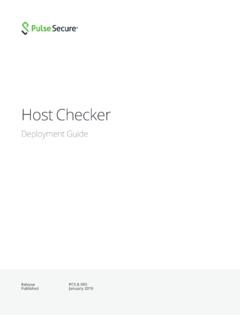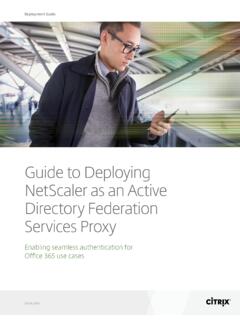Transcription of Using Microsoft Azure Active Directory MFA as SAML IdP ...
1 Using Microsoft Azure Active Directory MFA as SAML IdP with Pulse Connect Secure Deployment Guide May 2018 Microsoft Azure Active Directory as SAML IdP with Pulse Connect Secure 2018 Pulse Secure, LLC. All rights reserved 2 Introduction This document describes how to set up Pulse Connect Secure for SP-initiated SAML authentication Using the Microsoft Azure Active Directory as the SAML IdP. It also describes the user experience with Web browser and Pulse Secure Client access methods. Prerequisites Ensure you have the following: Administrative access to the Azure Management Portal o Azure subscription that includes Active Directory and Multi-Factor authentication (MFA) Pulse Connect Secure appliance running or later.
2 Process Steps The set up includes the following process steps: Setting up Microsoft Azure Active Directory Setting up Pulse Connect Secure Microsoft Azure Active Directory as SAML IdP with Pulse Connect Secure 2018 Pulse Secure, LLC. All rights reserved 3 Setting up Microsoft Azure Active Directory Perform the following steps to configure Azure AD: 1. Log into the Azure Management Portal. 2. In the left pane, select Active Directory . 3. Select an Active Directory from the Active Directory list, and click APPLICATIONS.
3 4. Click the Add button at the bottom center of the page, click ADD. Microsoft Azure Active Directory as SAML IdP with Pulse Connect Secure 2018 Pulse Secure, LLC. All rights reserved 4 5. In the pop-up window displayed, click Add an application my organization is developing. 6. In the Tell us about your application window, enter a name for the application. This has only local significance inside Azure . Example: PCS-MFA Keep the default option, WEB APPLICATION AND/OR WEB API, and click Next to continue. 7. In the App properties window, do the following: Microsoft Azure Active Directory as SAML IdP with Pulse Connect Secure 2018 Pulse Secure, LLC.
4 All rights reserved 5 a. SIGN-ON URL Enter a URL. As this solution is supported only for SP-Initiated SAML authentication , meaning the user will first connect to the Pulse Connect Secure service and then be redirected to Microsoft Azure . This URL is never used, but it must be provided. In this example, it is b. APP ID URI This is a VERY important entry, as it must match the unique Service Provider (SP) Entity ID configured in the Pulse Connect Secure SAML authentication Server later in this document. By default, in the Pulse Connect Secure, this is set to: https://[fqdn of PCS]/dana-na/ where the ending sp1 indicates it is the first SAML Service Provider.
5 As there could be others already defined, you might have to go back and change this later. In this example, this is set to ; click the tick mark to complete. Note: App ID URI can be changed later. So, do not worry if you did not get this correct. 8. After the application is added, click CONFIGURE. 9. Scroll down to the single sign-on section and verify that App ID URI is the same as in step , that is Note, that this must match the unique Service Provider (SP) Entity ID to be configured on the PCS SAML authentication server.
6 Microsoft Azure Active Directory as SAML IdP with Pulse Connect Secure 2018 Pulse Secure, LLC. All rights reserved 6 10. Change the REPLY URL to the SAML consumer URL that is used in Pulse Connect Secure. This has the format: https://[fqdn of PCS]/dana-na/auth/saml-consumer. In this example, it is: 11. Click the Save button at the bottom of the page. 12. Click VIEW ENDPOINTS at the bottom of the screen. The App Endpoints window displays the list of endpoints. Note that the Federation Metadata Document URL is the Metadata URL for this application.
7 In this example: Copy and save this URL. We will return to this later in the Pulse Connect Secure configuration. 13. Close the VIEW ENDPOINTS page by clicking the tick mark. 14. Click MANAGE MANIFEST at the bottom of the screen, and select Download Manifest and save the file to your local machine. 15. Open the file in a notepad from the saved location and search for logoutUrl .. "homepage": " ", "identifierUris": [" "], "keyCredentials": [], "knownClientApplications": [], Microsoft Azure Active Directory as SAML IdP with Pulse Connect Secure 2018 Pulse Secure, LLC.
8 All rights reserved 7 "logoutUrl": null, "oauth2 AllowImplicitFlow": false, .. 16. Configure the logoutUrl: It has the format like https:// [fqdn of PCS] So in this example it is: .. "homepage": " ", "identifierUris": [" "], "keyCredentials": [], "knownClientApplications": [], "logoutUrl": " ", "oauth2 AllowImplicitFlow": false, .. 17. Save the file. 18. Click MANAGE MANIFEST at the bottom of the screen, and select Upload Manifest. 19. In the Upload Manifest window, browse and upload the file you saved. This concludes the setup in Microsoft Azure .
9 In next section you will configure the Pulse Connect Secure to use this IdP as a SAML authentication server. Microsoft Azure Active Directory as SAML IdP with Pulse Connect Secure 2018 Pulse Secure, LLC. All rights reserved 8 Setting up Pulse Connect Secure To configure Pulse Connect Secure as a SAML Service Provider (SP) to Azure as the SAML IdP, start by importing the metadata from Azure . 1. Go to System > Configuration > SAML. 2. Select New Metadata Provider. 3. Set a name for the Metadata provider. 4. In the Metadata Provider Location Configuration section: o If the Pulse Connect Secure has internet access from the Internal interface, the Remote option can be used with the URL copied in step 12 above.
10 In this example: o If the Pulse Connect Secure do not have internet access from the Internal interface, open a browser and go to the saved URL. In this example: And save the content in a file on your local computer. Then use the Local option and upload the metadata to Pulse Connect Secure. Microsoft Azure Active Directory as SAML IdP with Pulse Connect Secure 2018 Pulse Secure, LLC. All rights reserved 9 5. Select the Identity Provider (IdP) Role for the new Metadata provider, and save changes. 6. Create a SAML authentication Server.







